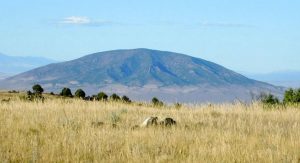
By| May 10, 2022
A yearslong push by a diverse group of stakeholders who want federal Wilderness protections around and including the Cerro de la Olla caldera in the Rio Grande del Norte National Monument is gaining momentum again, according to U.S. Sen. Martin Heinrich’s office. “Sen. Heinrich advanced by unanimous consent legislation to establish Cerro de la Olla Wilderness within the Río Grande del Norte National Monument in Northern New Mexico,” Heinrich’s office said in a May 3 press release. “Heinrich’s legislation would preserve traditional uses and provide sanctuary to a wide range of wildlife species, while maintaining current access routes. The legislation now heads to the Senate Floor for full consideration.” “The area is close to Sen. Heinrich’s heart, he’s been elk hunting there,” Stuart Wilde, a local wilderness guide and conservation advocate said, adding that the “true alpine grassland” within the caldera — at 9,500 feet above sea level — and the high desert grassland below the caldera provide critical habitat for a large migratory herd of elk, among other species. “It’s smack in the middle of their east-west migration corridor,” Wilde said. “Rio Grande del Norte has one of the largest herds in the winter time. We’ve done flyovers with members of the congressional delegation, and on any given day there could be 10,000 elk. It’s such a unique ecology compared to the rest of the national monument.” An identical House bill was introduced by U.S. Rep. Teresa Leger Fernández last year around this time. If passed, the legislation will complete a trifecta of wilderness areas within the Rio Grande del Norte National Monument, a 246,000-acre area on the Taos Plateau that was created by an executive order issued in 2013 by President Barack Obama. Wilde said the National Monument was created after federal legislation to create a National Conservation Area across approximately the same 246,000 acres stalled out. “When the area became a national monument, part of that was to remove the wilderness proposal, because that’s a different legislative instrument,” he said. “So the Rio Grande del Norte became a national monument, and the wilderness was transferred to another piece of legislation, the Cerros del Norte Conservation Act.” In 2018, the federal Cerros del Norte Conservation Act established the 13,420-acre Cerro del Yuta Wilderness and Rio San Antonio Wilderness Area within the Rio Grande del Norte National Monument, “but the Cerro de la Olla Wilderness got left out of it,” Wilde said, grateful for Heinrich’s push to move the reintroduced Cerro de la Olla legislation through the Senate Energy and Natural Resources Committee, which it passed last week. Wilde noted that the Rio Grande del Norte Coalition, which was established in 2007 and continues to advocate for the Cerro de la Olla Wilderness designation, is composed of stakeholders from a diverse set of Taos County communities, including Taos Pueblo, which considers the mountain part of its sacred ancestral lands. Ranchers, including those with grazing allotments within the proposed wilderness, along with advocates for the environment, hunters, outdoor recreationists, business owners and local and federal elected officials have expressed support for the designation. “This legislation has gained the support of a wide range of community members, as well as the Taos County Commission and Taos Pueblo,” Heinrich said in a statement to the Taos News. “Cerro de la Olla provides critical security habitat for species such as elk, mule deer, black bears and mountain lions. Protecting this impressive volcanic shield and its spectacular views has long been a priority for the Taos community. I’m proud that this legislation is advancing to the full Senate for consideration and will continue the work to expand the Rio Grande del Norte National Monument and protect an iconic New Mexico viewshed.” Wilde agreed that there’s been broad community support for the proposed wilderness designation. “Olla means ‘pot,’ like a vessel,” he said. “And there are several really important archeological sites on the flanks of those mountains that go all the way back to the paleolithic people, who would have waited for deer and elk there. “It’s also been very significant for the Spanish settlers and more recent local people, all of whom have long used it for hunting.” Wilderness designation would protect those cultural sites and traditional land uses, including several primitive campsites part way up the side of the mountain — and the roads leading to them. “When we looked at the [proposed] wilderness boundaries, I was personally adamant about having cherry stems — strips of land within Wilderness areas where motorized travel is permitted — so the roads could still be used,” Wilde said. “We wanted to make sure people could still use those.” Garrett Vene Klassen, northern conservation director for New Mexico Wild, called the proposed wilderness designation “more than appropriate.” “I’ve been hunting elk and gathering firewood in and around Cerro Olla for 25 years,” he said. “This remarkable cultural and ecological heirloom is deserving of the highest form of permanent legislative protection.”

